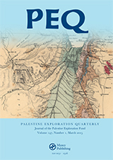
Palestine Exploration Quarterly
Scope & Guideline
Bridging History and Heritage in Palestine Studies
Introduction
Aims and Scopes
- Archaeological Research:
The journal publishes original research articles focused on archaeological excavations and surveys in Palestine and the Near East, highlighting significant findings and their implications for understanding historical contexts. - Cultural Heritage Studies:
Papers often explore the preservation and representation of Palestinian cultural heritage, addressing contemporary issues related to identity, memory, and the impact of conflict on heritage sites. - Historical Analysis:
The journal features studies that analyze historical texts and inscriptions, providing insights into the socio-political and economic landscapes of ancient and medieval Palestine. - Methodological Innovations:
There is a consistent focus on methodological advancements in archaeology, including experimental archaeology, zooarchaeology, and the application of new technologies in fieldwork and analysis. - Interdisciplinary Approaches:
Research often integrates perspectives from history, anthropology, and sociology, promoting a holistic understanding of the past and its relevance to contemporary issues.
Trending and Emerging
- Modern and Contemporary Archaeology:
There is a noticeable increase in studies addressing modern archaeological practices and their implications for contemporary Palestinian identity and heritage, reflecting a response to current political and social issues. - Maritime Archaeology:
Emerging themes in maritime archaeology highlight the significance of coastal and underwater sites, particularly in the Gaza Strip, indicating a growing interest in the historical interactions between land and sea. - Interdisciplinary Cultural Studies:
Recent papers increasingly integrate cultural studies with archaeological findings, focusing on themes like cultural appropriation, memory, and identity, reflecting a broader trend towards interdisciplinary research. - Environmental Archaeology:
The journal is seeing more studies that investigate human-environment interactions and the role of climate in shaping historical developments, emphasizing the ecological dimensions of archaeological research. - Community Engagement in Archaeology:
Emerging discussions around community involvement in archaeological practices and the impact of local narratives in shaping historical interpretations are gaining prominence, reflecting a shift towards collaborative research methodologies.
Declining or Waning
- Classical Archaeology:
Papers focusing on classical antiquity and Greco-Roman influences have seen a decrease, possibly due to a growing emphasis on local narratives and the importance of indigenous perspectives in historical discourse. - Colonial Perspectives:
Research that primarily examines the colonial history of Palestine without integrating local narratives or contemporary implications appears to be waning, as scholars increasingly prioritize post-colonial critiques. - Traditional Pottery Studies:
The once prevalent focus on traditional pottery typologies has diminished, with more emphasis now placed on broader socio-economic contexts and the role of pottery in daily life rather than mere classification.
Similar Journals

Aula Orientalis
Bridging Disciplines in Near Eastern StudiesAula Orientalis, an esteemed academic journal published by the Universitat de Barcelona's Institute of Ancient Near Eastern Studies, serves as a vital platform for scholarly discourse in the field of Near Eastern Archaeology, History, and Philology. With an ISSN of 0212-5730, this journal aims to disseminate high-quality research, fostering a deeper understanding of the ancient Near East through the publication of articles, reviews, and discussions by leading experts and emerging scholars alike. Although the journal has undergone changes in its indexing status, it continues to maintain a focus on rigorous academic standards and relevance in the global research community. Positioned at the crossroads of history and archaeology, Aula Orientalis encourages interdisciplinary collaboration and is ideal for researchers, professionals, and students seeking to expand their knowledge and engage with contemporary issues in ancient studies.
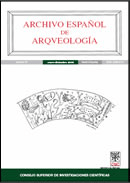
Archivo Espanol de Arqueologia
Elevating archaeological discourse through quality research.Archivo Español de Arqueología is a prestigious journal published by the Consejo Superior de Investigaciones Científicas (CSIC), dedicated to the field of archaeology and the historical sciences. Since its transition to Open Access in 1991, this journal has been a significant resource for scholars and practitioners in Spain and beyond, ensuring the dissemination of high-quality research to a broad audience. With an impressive Scopus ranking that places it within the top 20% of journals in the disciplines of History and Archaeology, Archivo Español de Arqueología plays a crucial role in advancing academic discourse and promoting innovative archaeological methodologies. The journal has maintained rigorous standards, reflected in its placement within the Q2 and Q3 quartiles, enabling it to establish a reputation for excellence and reliability in archaeological scholarship. Researchers, professionals, and students are encouraged to explore the journal's diverse array of articles from its foundation year of 2009 to the present, enriching their understanding of the past through the latest findings and theoretical advancements in archaeology.

Bulletin of the American Society of Overseas Research
Advancing global cultural understanding through scholarly dialogue.Bulletin of the American Society of Overseas Research, published by the University of Chicago Press, serves as a premier platform for scholarly discourse in the fields of archaeology, cultural studies, and history. With its ISSN 2769-3600 and E-ISSN 2769-3589, this journal has swiftly established itself as a key resource for researchers, professionals, and students alike, demonstrating exceptional impact as evidenced by its Q1 rankings in multiple relevant categories for 2023. Notably, it holds the 93rd percentile rank in Arts and Humanities (History) and the 84th percentile in Social Sciences (Cultural Studies), evidencing its respected standing within the academic community. The journal's commitment to advancing knowledge and fostering interdisciplinary dialogue is complemented by its accessible publication from 2022 to 2024, making it an essential read for those engaged in the exploration of global cultural histories and archaeological research.
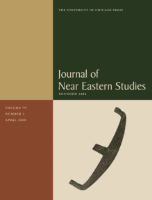
JOURNAL OF NEAR EASTERN STUDIES
Exploring the Rich Tapestry of Near Eastern HeritageJournal of Near Eastern Studies (ISSN: 0022-2968; E-ISSN: 1545-6978), published by University of Chicago Press, stands as a cornerstone of academic discourse in the fields of Archaeology, Cultural Studies, and Linguistics and Language. With a prestigious track record that has evolved since its inception and spanning converged publication years from 1968 to 2024, this journal holds an impressive Q1 ranking in Cultural Studies and Linguistics and Language, and a solid Q2 ranking in Archaeology and Arts and Humanities as of 2023. Despite not offering open access, it is widely regarded for its rigorous peer-reviewed articles that contribute significantly to the understanding of Near Eastern history, culture, and languages. The journal's sustained recognition in Scopus rankings, including a notable 30th rank out of 173 in Arts and Humanities, ensures it remains an essential resource for researchers, academics, and students dedicated to exploring the rich tapestry of the Near East. With its base in Chicago, USA, the Journal of Near Eastern Studies continues to foster interdisciplinary collaboration and scholarly excellence.
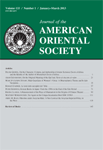
JOURNAL OF THE AMERICAN ORIENTAL SOCIETY
Illuminating the Rich Tapestry of the OrientThe JOURNAL OF THE AMERICAN ORIENTAL SOCIETY, published by the American Oriental Society, is a prestigious academic journal based in the United States that serves as a vital resource for researchers and scholars engaged in the fields of Asiatic studies, cultural studies, and broader humanities. Established to foster scholarly communication, this journal presents rigorous peer-reviewed articles and critical analyses that explore the diverse cultural, historical, and linguistic dimensions of the Orient. With an impact factor reflecting its scholarly significance, it occupies a Q3 position in Arts and Humanities (miscellaneous) and a Q2 ranking in Cultural Studies as of 2023. Although it does not currently offer open access, the journal maintains a strong reputation for its scholarly contributions, making it an essential platform for disseminating research findings. By bridging gaps in knowledge and fostering interdisciplinary dialogue, the JOURNAL OF THE AMERICAN ORIENTAL SOCIETY remains a cornerstone for those committed to the exploration of Asian cultural heritage and philosophy, enriching the academic community's understanding in these vital fields.

Vestnik Permskogo Universiteta-Istoriya-Perm University Herald-History
Charting New Territories in Historical ResearchVestnik Permskogo Universiteta-Istoriya (Perm University Herald-History), published by Perm State National Research University, serves as a pivotal academic platform for scholars in the fields of History, Archaeology, and Cultural Studies. With an ISSN of 2219-3111 and an impressive trajectory of convergence from 2019 to 2024, this journal has secured a commendable Q1 ranking in History and is recognized in the Q2 quartile across multiple relevant categories, demonstrating its significance in the scholarly landscape. Despite the absence of an open access model, the journal remains highly impactful and continues to contribute richly to the discourse surrounding historical and cultural research within the Russian Federation and beyond. The journal publishes original research, reviews, and theoretical papers, making it essential reading for those engaged in historical studies and related fields.
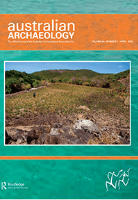
AUSTRALIAN ARCHAEOLOGY
Advancing the Frontiers of Archaeological Knowledge.AUSTRAILIAN ARCHAEOLOGY, published by Taylor & Francis Ltd, is a leading academic journal dedicated to the field of archaeology. With a strong reputation as evidenced by its Q1 ranking in both the Arts and Humanities and Social Sciences categories, this journal fosters the growth and dissemination of pioneering research from diverse archaeological contexts. The journal has been a vital resource for scholars and practitioners since its convergence in 2002, supporting the collective advancement of knowledge in the archaeological discipline. By offering a platform for rigorous analysis and critical discussions, AUSTRAILIAN ARCHAEOLOGY appeals to a wide audience, from established researchers to students beginning their journey in archaeology. Although it is not an Open Access journal, the insights provided are invaluable for enhancing understanding and appreciation of Australia’s rich archaeological heritage. With a Scopus ranking that places it among the top contenders in its field, this journal continues to contribute significantly to outstanding archaeological scholarship and professional practice.

Tusculum-Casopis Za Solinske Teme
Illuminating the Socio-Cultural Landscape of SolinTusculum-Casopis Za Solinske Teme is an esteemed academic journal dedicated to the exploration of relevant themes in social sciences and humanities, particularly focused on the historical and cultural landscape of Solin and its surroundings. Published by ZVONIMIR SOLIN, this journal aims to foster scholarly dialogue and promote research that contributes to the understanding of regional issues within a broader context. With its ISSN 1846-9469 and E-ISSN 1846-9469, it stands as a valuable resource for researchers, professionals, and students alike, serving as a platform for high-quality and original research articles. While currently not an open-access journal, it adheres to rigorous academic standards, ensuring the integrity and quality of published work. The journal is committed to advancing knowledge and promoting intellectual exchange, making it a vital component for those interested in the socio-cultural studies of this unique Croatian region.

OLBA
Exploring the Depths of Archaeological HeritageOLBA is a distinguished journal in the field of archaeology, published by Mersin University Publications Research Center Cilician Archaeology in Turkey. With an ISSN of 1301-7667, this academic journal has been a platform for scholarly discourse from 2009 to 2014 and again from 2016 to 2019, with a recent volume published in 2022. Although it is currently categorized in the fourth quartile (Q4) for both Arts and Humanities and Social Sciences within archaeology, OLBA continues to contribute significantly to the global archaeology community. It serves as an essential resource for researchers, professionals, and students interested in the diverse aspects of archaeological studies and cultural heritage. Despite not being an open-access journal, OLBA strives to disseminate knowledge effectively, aiding in the exploration of ancient civilizations and the rich tapestry of human history. Its Scopus rankings, placing it in the bottom percentiles, demonstrate the ongoing need for the community to support and engage with the journal to enhance its visibility and impact in the archaeological domain.

California Archaeology
Illuminating California's Archaeological JourneyCalifornia Archaeology is a premier academic journal dedicated to the multifaceted study of archaeology within the context of California's rich historical and cultural landscape. Published by Routledge Journals, Taylor & Francis Ltd, this journal conveys cutting-edge research from 2009 to 2024 and is recognized for its impact in the field, with a commendable Q2 ranking in both archaeology and arts and humanities as of 2023. Scholars and practitioners are encouraged to disseminate their findings and insights through this journal, contributing to a deeper understanding of archaeological practices and interpretations in California. With access options designed to enhance the visibility of research, California Archaeology serves as an essential resource for professionals, students, and researchers devoted to advancing knowledge in archaeology, making it a cornerstone of academic discourse in the discipline.